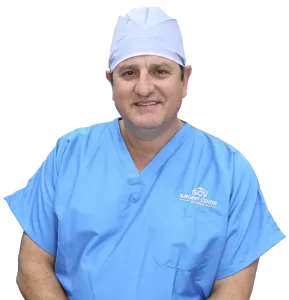
Facet joint syndrome is a disorder that resembles arthritis of the spine and can cause severe back and neck pain. Degenerative alterations to the joints between the spine bones are the root reason. The facet joint’s cartilage may deteriorate and inflame, sending pain signals to adjacent nerve terminals. Symptom management options include medication, physical therapy, joint injections, nerve blocks, and nerve ablations. Surgery to fuse the joint may be necessary if the symptoms persist.
If you or a loved one is experiencing any of the following symptoms outlined in this article, it’s time to get a FREE Consultation and MRI Review with Deuk Spine Institute. We will help relieve your pain and get you back to living your life without limitations!
The spine is composed of a column of flexible bones, or vertebrae, that are joined together.
With a big disc in the front and two facet joints in the back, each vertebra acts as a three-joint complex. The robust tripod shape keeps our spine flexible while maintaining the connection between the bones. Facets are synovial joints having cartilage lining, synovial fluid lubrication, and a joint capsule covering. Healthy facet joints allow the back to move smoothly without over-twisting. Arthritic discomfort, edema, and stiffness can be brought on by wear and tear to the disc and facet joint.
Facet joint syndrome or facet arthropathy refers to pain that originates from one or more facet joints. Weight distribution on the facet joints may be unequal as a result of degenerative alterations to the spine. This additional weight wears down the joint over time and modifies it: the joint capsule thins, the smooth cartilage degrades and becomes uneven like cobblestones, and bone spurs may develop Similar to knee joint arthritis, these modifications make it harder for the joint to move freely, and as a response, it becomes inflamed and irritated. Small nerves in the capsule known as the medial branch sensory nerves carry pain signals from the inflamed joint to the brain. As a result, the nearby muscles may tense and spasm.
Degeneration of the facet joints may not cause any discomfort up until a certain event. There are various signs that point to the facet joints as the source of a person’s pain. In the low back, directly over the spine, the pain is frequently a diffuse, dull ache that might radiate to the buttocks. It can be felt in the shoulders and back of the skull in the neck.
Pain will be felt when bending rearward or twisting sideways toward the injured joint. Periods of idleness or standing still could make the pain worse. Sitting, leaning forward, or shifting positions are actions that remove pressure from the joint and may reduce pain. The discomfort of a disc herniation might often be mistaken for facet joint problems. If bone spurs develop and impinge on the spinal nerves, pain may be felt down the arms or legs. Chronic pain or recurrent episodes of pain are also possible.
What causes this?
The cartilage in our joints deteriorates as we age. Pain can be brought on by an injury, repetitive motions, obesity, poor posture, and other disorders of the spine that alter how the facet joints align and move. A degenerating vertebral disc might be the first sign of changes in the facet joints. The cartilage degrades, the joint space becomes smaller, and the bones rub against one another as the weight of the body transfers to the facet joint.
Who is most often impacted?
Both men and women can experience facet joint syndrome. Between the ages of 40 and 70, and in those who are prone to arthritis, it is most prevalent. People who have suffered from spine injuries may also develop it.
How are accurate diagnoses arrived at?
Facet pain can resemble other spinal disorders. To determine whether the facet joint is the cause of your pain, a precise diagnosis is crucial. A medical history and physical examination are part of the evaluation. The doctor will take into account all of the details given, including any injury history, the location of your pain, and any issues with standing or sleeping.
You could be asked to stand or move about while indicating the location of your pain. The doctor might adjust your joints or check for spine-related soreness. To aid with the diagnosis and to search for further spine and hip-related issues, imaging procedures such as X-rays, CT scans, or MRIs may be prescribed. In a minimally invasive treatment called a facet joint injection, a corticosteroid and an analgesic-numbing drug are injected into the troublesome joint.
To identify the source of pain, a diagnostic facet joint injection is frequently used. Corticosteroids and local anesthetic are administered into the facet joint. X-ray fluoroscopy is used to administer the injection to ensure that the needle is placed precisely in the facet joint. Your pain threshold is assessed prior to, 20–30 minutes after, and over the course of the next week. If your pain level drops by greater than 75%, facet joint involvement has been established. It is doubtful that the facet joint is the source of your pain if it does not decrease after the injection.
What therapies are offered?
Although facet joint arthritis cannot be cured, there is evidence that exercise, a change in lifestyle, and cautious back pain management can all improve quality of life. Injections, ablations, or surgery may be advised by your doctor if conservative therapy is unsuccessful in helping you manage and control the pain.
Self-care: You can prevent uncomfortable episodes by maintaining proper posture and keeping your spine in alignment. Your regular standing, sitting, and sleeping routines may need to be modified. Weight loss can lessen the strain on the facet joints and relieve pain.
Physical treatment: When you have a sore facet joint, exercise is incredibly beneficial and can hasten your recovery. Physical therapists will work with you to strengthen and stretch your lower back, leg, and stomach muscles as well as teach you proper lifting and walking skills. You must perform the stretching and strengthening exercises even if a physical therapist may demonstrate them to you.
Medication: Some patients may require mechanical bracing, topical patches, lotions, or salves, as well as oral anti-inflammatory drugs. For muscle spasms, muscle relaxants are occasionally administered.
Injections of a corticosteroid: An analgesic-numbing substance is injected into the sore joint during a facet joint injection, a minimally invasive treatment. The swelling and inflammation of the nerves can be reduced with steroids. With physical therapy and an exercise regimen, your condition can improve thanks to pain reduction, which can endure for days or even years. The surgery can be repeated if you have a recurrence of pain. To alleviate pain, an anesthetic is given along the nerve.
Radiofrequency ablation of the nerves: This joint capsule may be advised if steroid joint injections are effective but discomfort is still present frequently. To identify the nerves that need to be treated, a diagnostic nerve block test is first carried out. To “block” pain, an anesthetic is given along the nerve. A radiofrequency ablation will probably offer greater long-lasting pain relief if the block is effective.
Some of the medial branch nerve fibers transmitting pain signals in the joint are damaged by a radiofrequency current when an electrode is implanted. Following the insertion of the needle and electrode, a radiofrequency current is used to damage part of the medial branch nerve fibers that are responsible for transmitting pain signals to the joint. Similar to how nerve blocks are carried out, so is a nerve ablation operation. Following the insertion of the needle, an electrode and radiofrequency current are used to damage some of the medial branch nerve fibers sending pain signals to the joint. Pain alleviation could endure for nine months or longer.
Surgery: If no other pain management options work, spine fusion surgery can be a possibility. This typically happens when spinal instability, degenerative disc degeneration, or larger facet joints compress a nerve root.
Restoration and avoidance
It’s critical to keep in mind that while radiofrequency ablations and injections may relieve symptoms, the underlying degeneration of the spine remains unchanged. By enhancing the general strength and condition of the back and reducing inflammation in the body, regular stretching, strengthening, and cardiovascular exercise may decrease the degeneration process and reduce stress on the facet joints.
The Deuk Spine Institute encourages and welcomes you to contact us today regarding any questions or concerns you may have regarding your current situation.
If you or someone you love is experiencing any of the preceding symptoms outlined, it is imperative to get a FREE Consultation and MRI Review with the Deuk Spine Institute. We can help relieve your pain and get you back to living your life without limitations!

